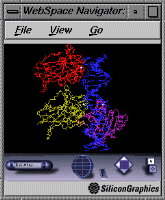BioVRML, VRML in Biochemistry
Dateline: 11/10/97
 Molecules, protiens, chemical bonding, don't all those biochemical terms
just bring a chill up your spine? Ok maybe not. But for those people who
do have a burning desire to see what these molecules look like and how
they move, VRML is a wonderful, and free, way to visualize them. Certainly
the pioneer of VRML molecular imaging are the folks of the Department of
Physical Chemistry at the Darmstadt
University of Technology in Germany. Their web page titled "VRML
in Chemistry" with the paper "VRML for the communication with 3D scenarios
of biomolecules" let's users select from hundreds of molecules and protiens
which can be displayed in several forms. Molecules can be viewed using
stick, ball and stick, space filling representations. Some of the VRML
files even contain VRML objects they call "space buttons" (click on the
image on the top of this article for one such world) to control the information
and type of display.
Molecules, protiens, chemical bonding, don't all those biochemical terms
just bring a chill up your spine? Ok maybe not. But for those people who
do have a burning desire to see what these molecules look like and how
they move, VRML is a wonderful, and free, way to visualize them. Certainly
the pioneer of VRML molecular imaging are the folks of the Department of
Physical Chemistry at the Darmstadt
University of Technology in Germany. Their web page titled "VRML
in Chemistry" with the paper "VRML for the communication with 3D scenarios
of biomolecules" let's users select from hundreds of molecules and protiens
which can be displayed in several forms. Molecules can be viewed using
stick, ball and stick, space filling representations. Some of the VRML
files even contain VRML objects they call "space buttons" (click on the
image on the top of this article for one such world) to control the information
and type of display.
The Darmstadt folks wisely chose to write a converter,
PDB-to-VRML,
which converts files in the PDF format, a widely used protein format,
and VRML. There exist large databases of protiens, such as the Brookhaven
Protein Databank used by the biotechnology research and commercial
communities. One of the few "industrial strength" uses of VRML is as a
visualization of the molecules in this important international database.
If you search for a protein you can retrieve a VRML molecule visualization.
The latest Darmstadt contribution is a collection of VRML models that
move. Using the capabilities of VRML 2 this page illustrates the
motion of molecules
for the selected frequencies. Last but not least, from Darmstadt, is
a web page on the use of VRML for Cancer research. This web page titled
"VRML in Cancer Research: Local Changes in Binding Properties of Wild Type
and Mutated p53 Tumor Suppressor Protein" by M. Keil, G. Moeckel, J. Brickmann
presents a half dozen VRML worlds as visualizations of various affects
of cancer on the p53 gene mutations.
The use of chemical data types on the Internet in general has grown
to such a degree that a collection of MIME
types specifically for chemistry exists. These MIME types encode representations
for proteins (.pdb), crystallographic information (.cif), nucleotides
(.emb) and lots more.
When building a good VRML chemistry application, one should first see
what models already exist. The people at OCNUS have some chemical
molecules for clip art. They feature caffeine, ethanol and the always
popular nutrasweet. If your feeling a little hungry and in need of some
amino acids for your VRML diet, check out the Image Library of Biological
Macromolecules (IMB) with it's collection of the 20
Standard Amino Acids. Don't stop just at Amino Acids though check out
the IMB's Virtual Reality Division
with VRML models of Nucleotides, Proteins, RNA, DNA, and Carbohydrates.
It's a veritable smorgasbord of VRML biochemical models. Well that's about
it for this week, all this talk of proteins and carbohydrates
are making me hungry.
Previous
Features
 Molecules, protiens, chemical bonding, don't all those biochemical terms
just bring a chill up your spine? Ok maybe not. But for those people who
do have a burning desire to see what these molecules look like and how
they move, VRML is a wonderful, and free, way to visualize them. Certainly
the pioneer of VRML molecular imaging are the folks of the Department of
Physical Chemistry at the Darmstadt
University of Technology in Germany. Their web page titled "VRML
in Chemistry" with the paper "VRML for the communication with 3D scenarios
of biomolecules" let's users select from hundreds of molecules and protiens
which can be displayed in several forms. Molecules can be viewed using
stick, ball and stick, space filling representations. Some of the VRML
files even contain VRML objects they call "space buttons" (click on the
image on the top of this article for one such world) to control the information
and type of display.
Molecules, protiens, chemical bonding, don't all those biochemical terms
just bring a chill up your spine? Ok maybe not. But for those people who
do have a burning desire to see what these molecules look like and how
they move, VRML is a wonderful, and free, way to visualize them. Certainly
the pioneer of VRML molecular imaging are the folks of the Department of
Physical Chemistry at the Darmstadt
University of Technology in Germany. Their web page titled "VRML
in Chemistry" with the paper "VRML for the communication with 3D scenarios
of biomolecules" let's users select from hundreds of molecules and protiens
which can be displayed in several forms. Molecules can be viewed using
stick, ball and stick, space filling representations. Some of the VRML
files even contain VRML objects they call "space buttons" (click on the
image on the top of this article for one such world) to control the information
and type of display.